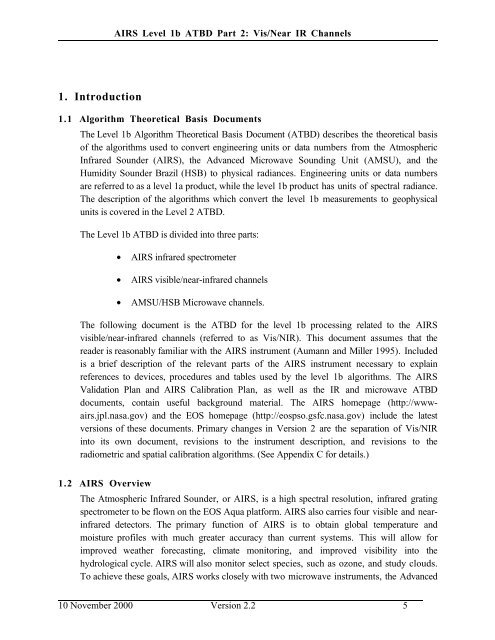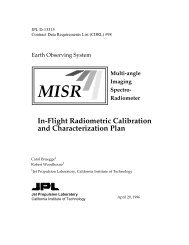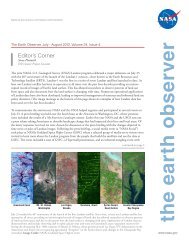AIRS Level 1B Visible/Near-Infrared Channels ATBD - NASA's Earth ...
AIRS Level 1B Visible/Near-Infrared Channels ATBD - NASA's Earth ...
AIRS Level 1B Visible/Near-Infrared Channels ATBD - NASA's Earth ...
You also want an ePaper? Increase the reach of your titles
YUMPU automatically turns print PDFs into web optimized ePapers that Google loves.
<strong>AIRS</strong> <strong>Level</strong> 1b <strong>ATBD</strong> Part 2: Vis/<strong>Near</strong> IR <strong>Channels</strong><br />
1. Introduction<br />
1.1 Algorithm Theoretical Basis Documents<br />
The <strong>Level</strong> 1b Algorithm Theoretical Basis Document (<strong>ATBD</strong>) describes the theoretical basis<br />
of the algorithms used to convert engineering units or data numbers from the Atmospheric<br />
<strong>Infrared</strong> Sounder (<strong>AIRS</strong>), the Advanced Microwave Sounding Unit (AMSU), and the<br />
Humidity Sounder Brazil (HSB) to physical radiances. Engineering units or data numbers<br />
are referred to as a level 1a product, while the level 1b product has units of spectral radiance.<br />
The description of the algorithms which convert the level 1b measurements to geophysical<br />
units is covered in the <strong>Level</strong> 2 <strong>ATBD</strong>.<br />
The <strong>Level</strong> 1b <strong>ATBD</strong> is divided into three parts:<br />
• <strong>AIRS</strong> infrared spectrometer<br />
• <strong>AIRS</strong> visible/near-infrared channels<br />
• AMSU/HSB Microwave channels.<br />
The following document is the <strong>ATBD</strong> for the level 1b processing related to the <strong>AIRS</strong><br />
visible/near-infrared channels (referred to as Vis/NIR). This document assumes that the<br />
reader is reasonably familiar with the <strong>AIRS</strong> instrument (Aumann and Miller 1995). Included<br />
is a brief description of the relevant parts of the <strong>AIRS</strong> instrument necessary to explain<br />
references to devices, procedures and tables used by the level 1b algorithms. The <strong>AIRS</strong><br />
Validation Plan and <strong>AIRS</strong> Calibration Plan, as well as the IR and microwave <strong>ATBD</strong><br />
documents, contain useful background material. The <strong>AIRS</strong> homepage (http://wwwairs.jpl.nasa.gov)<br />
and the EOS homepage (http://eospso.gsfc.nasa.gov) include the latest<br />
versions of these documents. Primary changes in Version 2 are the separation of Vis/NIR<br />
into its own document, revisions to the instrument description, and revisions to the<br />
radiometric and spatial calibration algorithms. (See Appendix C for details.)<br />
1.2 <strong>AIRS</strong> Overview<br />
The Atmospheric <strong>Infrared</strong> Sounder, or <strong>AIRS</strong>, is a high spectral resolution, infrared grating<br />
spectrometer to be flown on the EOS Aqua platform. <strong>AIRS</strong> also carries four visible and nearinfrared<br />
detectors. The primary function of <strong>AIRS</strong> is to obtain global temperature and<br />
moisture profiles with much greater accuracy than current systems. This will allow for<br />
improved weather forecasting, climate monitoring, and improved visibility into the<br />
hydrological cycle. <strong>AIRS</strong> will also monitor select species, such as ozone, and study clouds.<br />
To achieve these goals, <strong>AIRS</strong> works closely with two microwave instruments, the Advanced<br />
10 November 2000 Version 2.2 5







